This is a great question, and what makes it challenging is that the qplot/ggplot charts are static images. The below app.r is an example of how I would do it. I'd love to see other approaches.
In essence:
- Create a sequence of numbers that will be used both as the breaks in your histogram and as intervals in your dataframe. I based these on user inputs, but you could hardcode them.
- Assign a "bin" value to each row in the dataframe based on the interval in which the value falls.
- Record the x-coordinate from the user's click event and assign that a "bin" value based on the same set of intervals.
- Subset your dataframe and retain only those records where the "bin" value of the data matches the "bin" value of the x-coordinate from the user's click event.
Otherwise, if you're willing to go the d3 route, you could explore something like this posted by R Views.
#Load libraries ----------------------------------------------------
library(shiny)
library(ggplot2)
library(scales)
library(dplyr)
# Prepare data -----------------------------------------------------
df <- mtcars
df <- cbind(model = rownames(df), data.frame(df, row.names = NULL)) # setting the rownames as the first column
dm <- df$hp %>% as.matrix()
# UI function ------------------------------------------------------
ui <- fluidPage(
titlePanel("Histogram"),
sidebarLayout(
sidebarPanel(
tags$h5("I added the below text output only to demonstrate shiny's way for tracking user interaction on static plots. You can click, double-click, or click & drag (i.e. brushing). These functions are AWESOME when exploring scatterplots."),
tags$h3("Chart click and brushing"),
verbatimTextOutput("info"),
tags$h5("Now I'm applying the below UI inputs to the `vec` and `breaks` arguments in `findInterval()` and `qplot()` respectively; I'm using `findInterval()` to bin the values in the dataframe AND to bin the x-value of the user's click event input on the chart. Then we can return the dataframe rows with the same bin values as the x-value of the click input."),
sliderInput("seq_from_to"
, label = h3("Sequence 'From' and 'To'")
, min = 0
, max = 500
, value = c(50, 350)
),
sliderInput("seq_by"
, label = h3("Sequence 'By'")
, min = 25
, max = 200
, value = 50
, step = 5)
),
mainPanel(
plotOutput("hist",
click = "plot_click",
dblclick = "plot_dblclick",
hover = "plot_hover",
brush = "plot_brush"),
dataTableOutput("table")
)
)
)
# Server function --------------------------------------------------
server <- function(input, output) {
# Render Histogram Plot
output$hist <- renderPlot({
# Using the same `qplot` function but inserting the user inputs to set the breaks values in the plot
pp <- qplot(dm
, geom = "histogram"
, breaks = seq(from = input$seq_from_to[1], to = input$seq_from_to[2], by = input$seq_by)
, xlab = "values"
, ylab = "Frequency"
, main = "Histogram"
, fill = I("red")
, col = I("black")
, alpha = I(0.4)
)
# Also using the user inputs to set the breaks values for the x-axis
pp + scale_x_continuous(breaks = seq(from = input$seq_from_to[1], to = input$seq_from_to[2], by = input$seq_by))
})
# This is purely explanatory to help show how shiny can read user interaction on qplot/ggplot objects
# It's taken from the Shiny docs here: https://shiny.rstudio.com/articles/plot-interaction.html
output$info <- renderText({
# Retain the x and y coords of the user click event data
xy_str <- function(e) {
if(is.null(e)) return("NULL\n")
paste0("x=", round(e$x, 1), " y=", round(e$y, 1), "\n")
}
# Retain the x and y range coords of click & drag (brush) data
xy_range_str <- function(e) {
if(is.null(e)) return("NULL\n")
paste0("xmin=", round(e$xmin, 1), " xmax=", round(e$xmax, 1),
" ymin=", round(e$ymin, 1), " ymax=", round(e$ymax, 1))
}
# Paste this together so we can read it in the UI function for demo purposes
paste0(
"click: ", xy_str(input$plot_click),
"dblclick: ", xy_str(input$plot_dblclick),
"hover: ", xy_str(input$plot_hover),
"brush: ", xy_range_str(input$plot_brush)
)
})
# Back to the story. Set a listener to trigger when one of the following is updated:
toListen <- reactive({list(
input$plot_click # user clicks on the plot
, input$seq_from_to # user updates the range slider
, input$seq_by # user updates the number input
)
})
# When one of those events are triggered, update the datatable output
observeEvent(toListen(), {
# Save the user click event data
click_data <- input$plot_click
print(click_data) # during your app preview, you can watch the R Console to see what click data is accessible
# Assign bin values to each row using the intervals that are set by the user input
df$bin <- findInterval(dm, vec = seq(from = input$seq_from_to[1], to = input$seq_from_to[2], by = input$seq_by))
# Similarly assign a bin value to the click event based on what interval the x values falls within
click_data$x_bin <- findInterval(click_data$x, vec = seq(from = input$seq_from_to[1], to = input$seq_from_to[2], by = input$seq_by))
# Lastly, subset the df to only those records within the same interval as the click event x-value
df_results <- subset(df, bin == click_data$x_bin)
# Select what values to view in the table
df_results <- df_results %>% select(model, hp)
# And push these back out to the UI
output$table <- renderDataTable(df_results,
options = list(
pageLength = 5
)
)
})
}
shinyApp(ui = ui, server = server)
![enter image description here]()

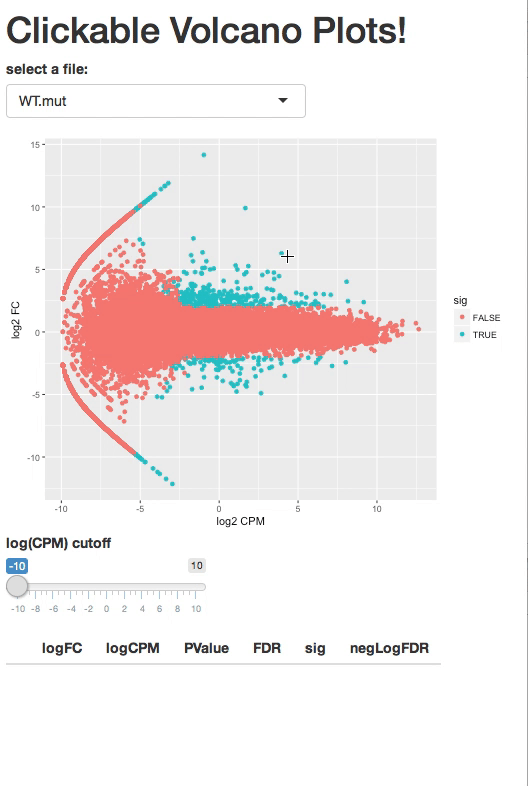
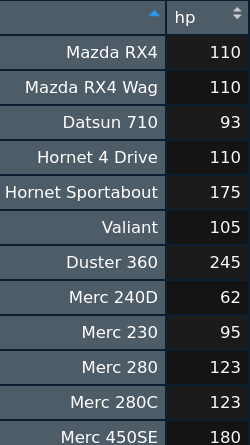
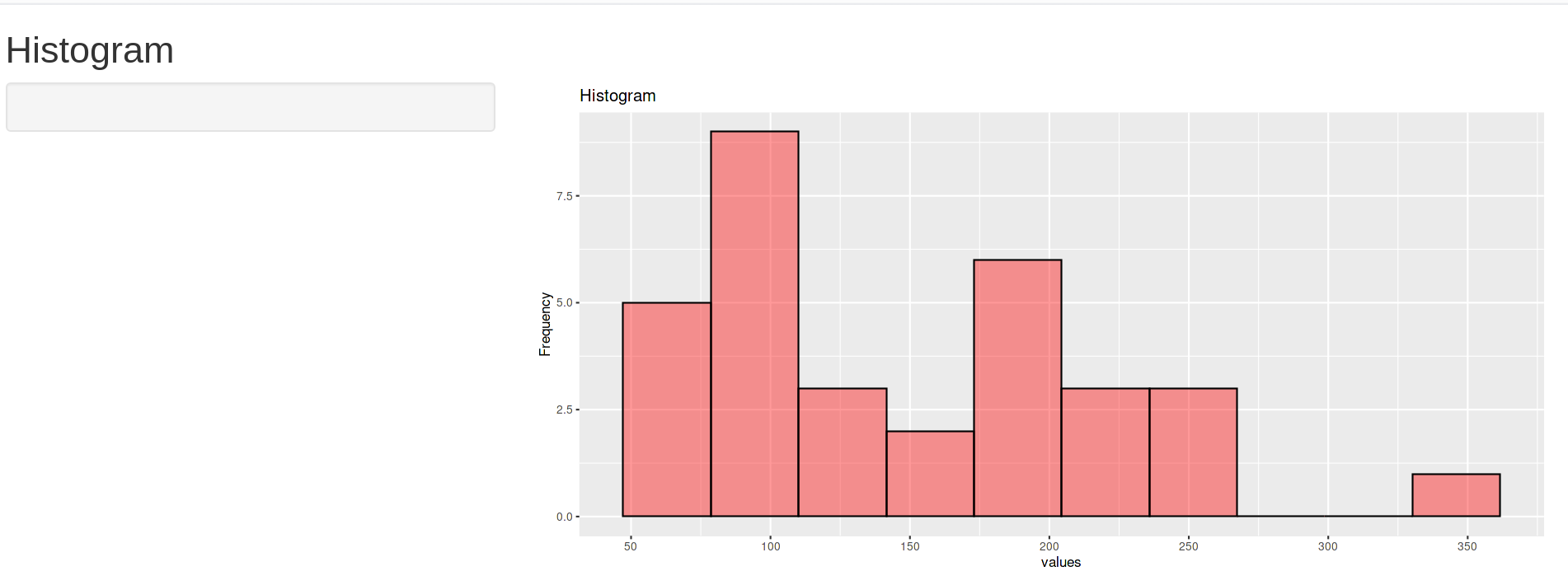
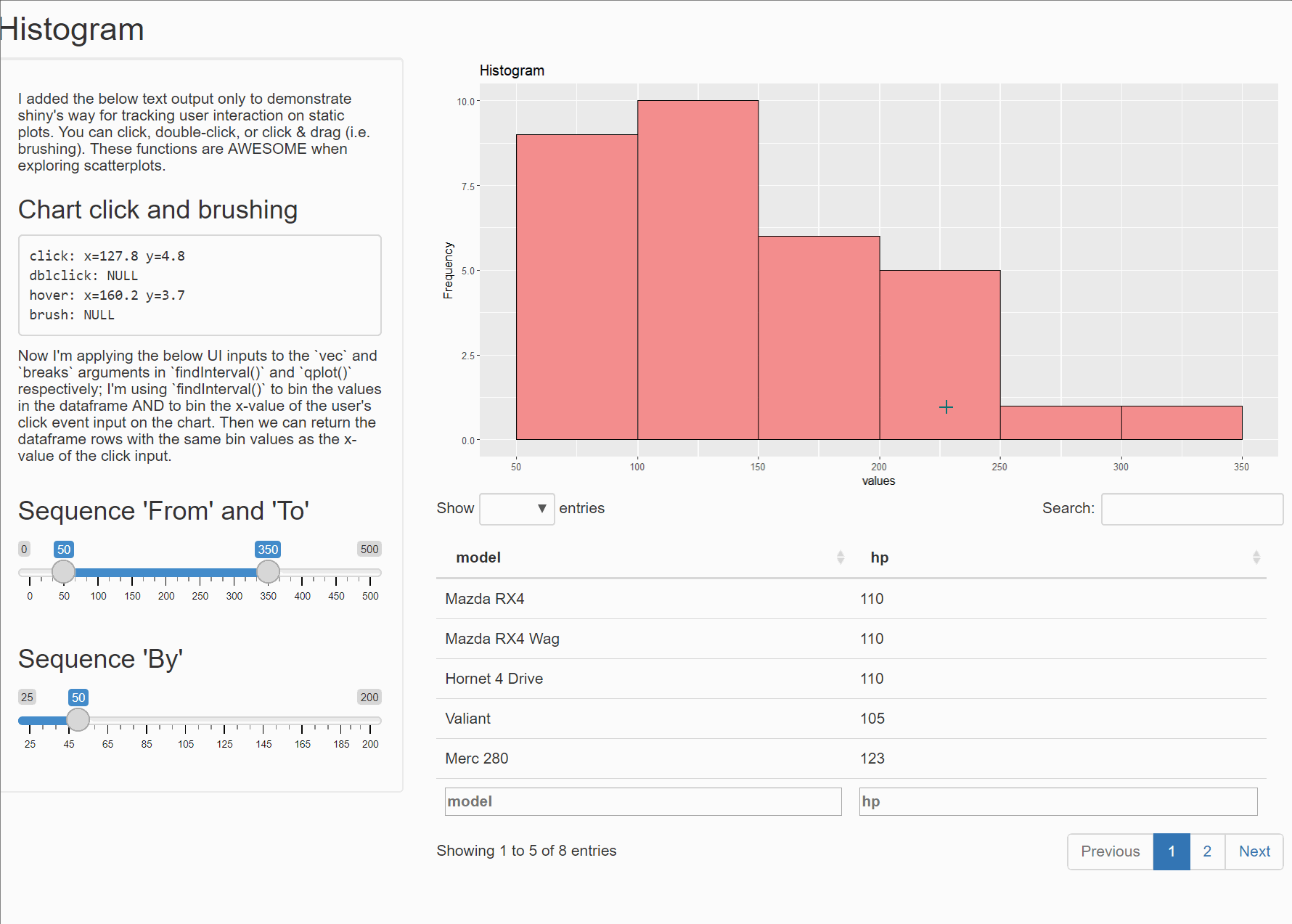
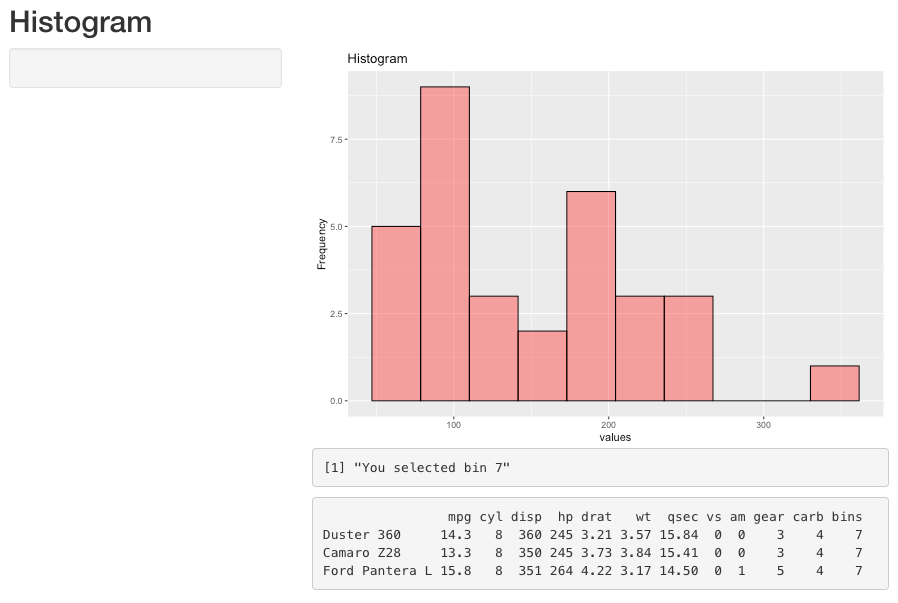
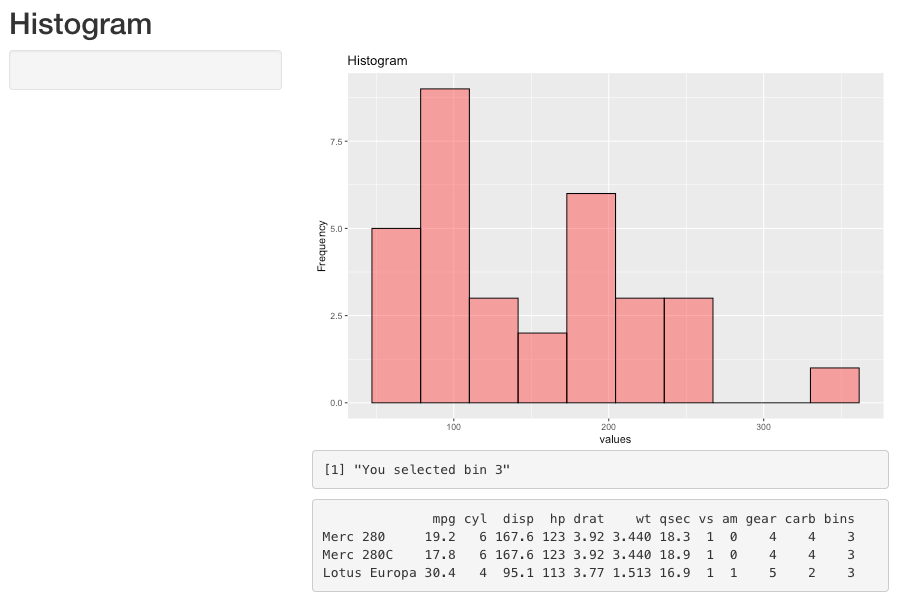
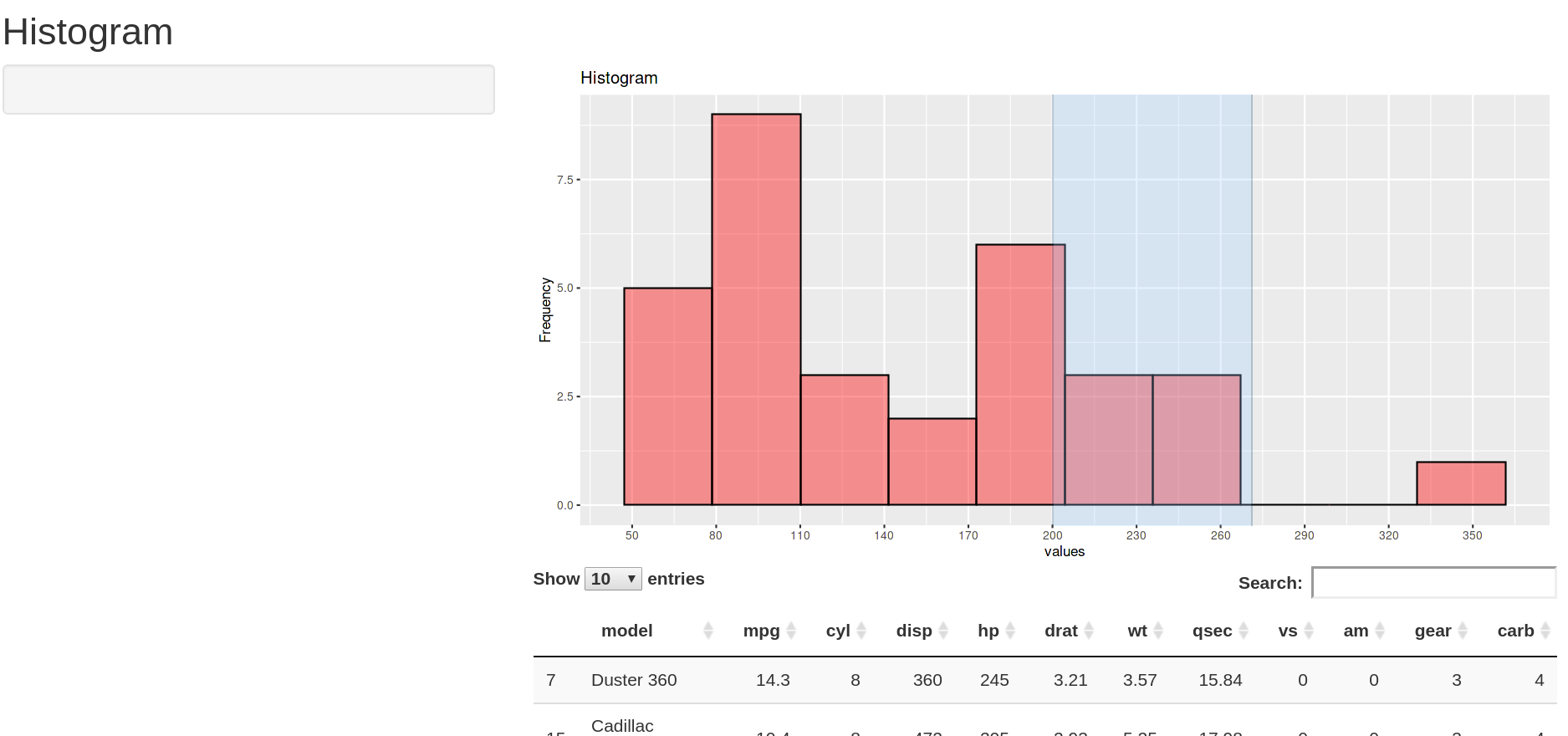
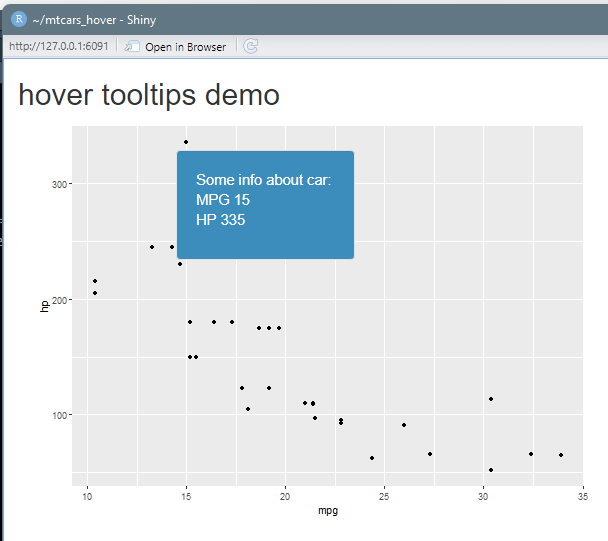
brushedPointsbut I need x and y, and I don't have the y. (shiny.rstudio.com/reference/shiny/0.12.0/brushedPoints.html) – Bunde